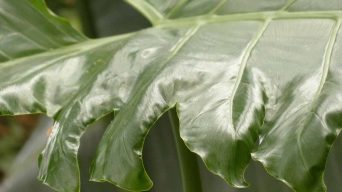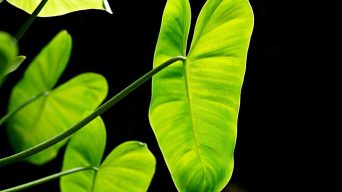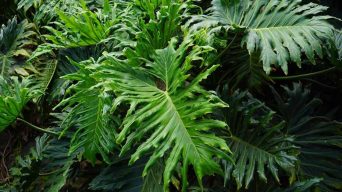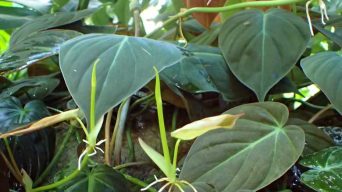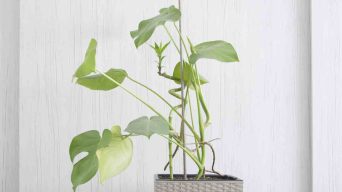Philodendron is a popular indoor plant known for its easy care and durability. However, even the most resilient plants can experience problems from time to time.
One common issue that philodendrons may experience is yellowing leaves.
Several possible reasons for this problem include nutrient deficiencies, overwatering, or too much sun exposure.
By understanding the causes of why are your Philodendron leaves turning yellow, you can take steps to correct the problem and keep your plant healthy.
Why Is My Philodendron Turning Yellow?
One of the most common problems that philodendron owners face is yellow leaves.
There are several reasons why this might happen, so it’s essential to take a closer look at your plant to identify the problem.
Here are some of the most common reasons why Philodendron leaves may be turning yellow:
1. Nutrient Deficiencies
A nutrient deficiency is one common reason philodendron leaves may be turning yellow.
While philodendrons are not heavy feeders, they require a consistent supply of nutrients to maintain their lush, green foliage.
A lack of nitrogen is one of the most common nutrient deficiencies that can cause philodendron leaves to turn yellow.
Nitrogen is an essential component of photosynthesis, so a nutrient shortage can reduce the plant’s ability to produce food.
Iron and potassium are other nutrient deficiencies that may cause plant leaves to turn yellow.
These nutrients play essential roles in plant metabolism and growth, so a deficiency can quickly lead to unhealthy plants.
How To Fix It
The best way to correct a nutrient deficiency is to fertilize your plant, especially in the spring and summer months.
A balanced fertilizer high in nitrogen will help to green up your plant and promote healthy growth.
Be careful not to overfertilize, as this can also cause problems. It’s always best to err on caution and fertilize less often than more.
You may also need to add some amendments to your soil to correct nutrient deficiencies. This is especially true for iron, as it can be difficult for plants to absorb this nutrient from a standard potting mix.
Adding a small amount of organic matter or compost to your soil can help to increase the nutrient content and improve plant health.
2. Overwatering
Another common reason for yellow leaves is overwatering.
Philodendrons are native to tropical rainforests and are accustomed to high humidity and consistent moisture.
Philodendron plants need to be watered regularly, but they should never be allowed to sit in water.
When the roots of a philodendron are constantly wet, they suffocate and cannot absorb the nutrients they need. This can lead to several problems, including yellow leaves.
Overwatering can cause other issues, such as root rot, leaf drop, and stunted growth.
The best way to water a philodendron is to allow the soil to dry out slightly between watering. This will ensure that the roots have access to oxygen and prevent them from rotting.
How To Fix It
If you think your plant is being overwatered, let the soil dry out completely before watering again.
It’s also a good idea to check your pot’s drainage to ensure the water is not sitting in the bottom and causing the roots to rot.
If you suspect your plant is suffering from overwatering, it’s also a good idea to repot it into fresh, well-draining soil.
3. Underwatering
When a Philodendron is not watered enough, its leaves will turn yellow.
While this may seem harmless at first, it can damage the plant.
The reason for this is that underwatering cause the leaves to lose moisture.
This loss of moisture causes the cells in the leaves to shrink and collapse. As a result, the leaves become less able to photosynthesize and ultimately die.
In addition to turning yellow, underwatering can cause Philodendron leaves to become dry and brittle.
These changes make the plant susceptible to further damage from pests and diseases.
It is essential to water your Philodendron weekly or more often if the plant grows in a hot, dry environment.
How To Fix It
If you think your Philodendron is underwatered, the best course of action is to water it thoroughly.
Be sure to soak the soil until water runs out of the drainage holes.
Once the plant has been watered, check the soil regularly to ensure it is not drying out too quickly.
If the soil dries out too quickly, this can indicate that the potting mix is not draining well or that the pot is too small.
In either case, it is best to repot the plant into fresh, well-draining soil.
When your Philodendron is appropriately hydrated, the leaves should begin to green up within a few days.
4. Too Much Sun
One of the most common problems for philodendron growers is yellow leaves.
While there are many possible causes of this phenomenon, one of the most common is too much sun.
Philodendrons are native to tropical rainforests and grow in the dappled sunlight beneath the canopy.
The leaves can be bleached and yellowed by intense direct sunlight when grown in full sun.
In addition, the plant may become stunted and produce fewer leaves.
A sunburned philodendron leaf will usually have yellow or brown patches.
How To Fix It
If you think your Philodendron is getting too much sun, the best solution is to move it to a location with less light.
Philodendrons thrive in bright indirect sunlight, so an east- or west-facing window is a good option.
You can also grow philodendrons under fluorescent lights, providing the plants with the bright indirect light they need without the risk of scorching their leaves.
If your Philodendrons plant is outdoors, you may need to provide shade during the day’s hottest hours.
You can grow it beneath a tree or use awnings or shade cloths.
5. Too Little Light
Philodendron plants are native to the tropical rainforests of South America, where they grow up trees in low light conditions.
In their natural habitat, they receive filtered sunlight or dappled shade.
When grown indoors, they should be placed in a spot that receives indirect sunlight.
If a Philodendron plant does not receive enough light, its leaves will turn yellow.
The yellowing of leaves is a common symptom of insufficient light exposure and is often seen in indoor plants.
Too little light can cause the leaves to lose their green color and become pale or yellow. In some cases, the philodendron leaves may also develop brown spots.
How To Fix It
If your Philodendron needs to receive more light, the best solution is to move it to a location with more light.
Philodendrons prefer bright indirect light, so a spot near a window would be ideal.
You should also ensure that the Philodendron is not in a shady spot where it might receive too little light.
If your Philodendron needs more light, you can use a grow light to supplement its light exposure.
Grow lights are a type of artificial light that you can use to provide plants with the light they need to grow.
6. Temperature Stress
Philodendron leaves typically turn yellow when they are stressed due to temperature changes.
While philodendrons are tropical plants that thrive in warm, humid conditions, sudden temperature changes can cause their leaves to turn yellow and drop off.
In some cases, the leaves may also develop brown or yellow spots.
Temperature stress is most likely to occur when philodendrons are exposed to drafts from open windows or doors or when placed in a room with a heater or air conditioner.
The ideal temperature range for philodendrons is between 60 and 75 degrees Fahrenheit.
The leaves will turn yellow if the temperature gets too hot or too cold.
How To Fix It
If you suspect your Philodendron is suffering from temperature stress, move it to a location where it will be protected from drafts and extreme temperatures.
In most cases, this will be enough to fix the problem, and the leaves will return to their normal color.
If the temperature stress is severe, you may need to take action to protect the plant from extreme temperatures.
For example, if the plant is outdoors and the temperature drops below freezing, you must bring it inside.
7. Pest Infestation
Pest infestations can also cause yellow leaves on Philodendrons.
The most common pests that infest philodendrons are aphids, mealybugs, and spider mites.
Several potential reasons pests might cause philodendron leaves to turn yellow.
One possibility is that the pests are feeding on the leaves, causing them to become damaged and discolored.
Another possibility is that the pests introduce toxins into the plant, leading to a yellow leaf.
In addition to yellowing leaves, pest infestations can cause stunted growth, leaf drop, and flower bud drop.
How To Fix It
The best way to deal with a pest infestation is to take preventive measures to avoid it in the first place. This includes keeping your philodendron plant healthy and free of stress and quarantining any new plants you bring into your home.
If you find pests on your Philodendron, you can try to remove them by hand or clean them off with a mild soap and water solution.
You can also use insecticidal soap or neem oil to eliminate pests. If the infestation is severe, you may need to use a stronger pesticide.
However, it is essential to use pesticides sparingly, as they can harm humans and animals.
8. Diseases
Several factors can cause Philodendron yellow leaves, but diseases are one of the most common.
Several diseases can cause philodendron leaves to turn yellow, including bacterial blight, root rot, and fungal leaf spot disease.
These diseases are often caused by too much moisture, either in the soil or in the air.
Root rot is a particularly problematic disease for philodendrons. It can quickly kill the roots and prevent the plant from retaining moisture and nutrients.
As a result, the leaves will turn yellow and eventually drop off. In some cases, the entire plant may die.
It is important to carefully inspect your plant for signs of disease and act quickly if you notice any issues to avoid this problem.
How To Fix It
If you think your Philodendron has a disease, in most cases, the best course of action is to remove the affected leaves. This will help prevent the disease from spreading and causing further damage to the plant.
Sometimes, you may also need to treat the plant with a fungicide or bactericide.
However, it is essential to use these products sparingly, as they can harm both humans and animals.
You must be particularly careful when dealing with root rot, as this disease can spread quickly and kill the entire plant.
If you think your Philodendron has root rot, removing the affected roots and replanting the plant in fresh, sterile soil is essential.
You may also need to treat the plant with a fungicide or bactericide.
9. Poor Soil Quality
Another common cause of yellow leaves on philodendrons is poor soil quality.
Philodendrons are native to tropical rainforests, where the soil is rich in organic matter and nutrients.
In contrast, most potting soils used for houseplants are relatively poor in nutrients.
As a result, philodendrons grown in these soils often have yellow leaves.
This problem is compounded by the fact that philodendrons are heavy feeders and require more nutrients than most other houseplants.
Avoiding this problem by using a high-quality potting mix rich in organic matter and nutrients is crucial.
You should also fertilize your plant regularly to ensure it gets the nutrients it needs.
How To Fix It
If your Philodendron is growing in poor-quality soil, repot the plant into a better potting mix.
Be sure to use a high-quality potting mix rich in organic matter and nutrients.
You should also fertilize your plant regularly to ensure it gets the nutrients it needs.
10. Overfertilization
Overfertilization is a common problem among gardeners and can cause various problems for plants.
One of the most common symptoms of overfertilization is yellowing leaves. This is because fertilizer contains high nitrogen levels, which can cause an imbalance in the plant’s water uptake.
When this happens, the plant’s leaves turn yellow in an attempt to reduce the amount of water they are losing.
Overfertilization can lead to leaf drop, stunted growth, and even death in severe cases.
To avoid this problem, it is essential always to follow the fertilizer label’s directions and use a light hand when applying it.
How To Fix It
If your plant shows signs of overfertilization, the best solution is to flush the potting soil with water. This will help remove some of the excess fertilizer from the soil and reduce the risk of further damage to the plant.
It would be best if you also refrained from fertilizing your plant for a few weeks to allow it to recover.
11. Natural Leaf Shedding
Leaf shedding is a natural process that all plants go through.
As the leaves age, they lose chlorophyll, the pigment that gives them their green color.
This process is accelerated in Philodendron plants when exposed to too much light or not receiving enough nutrients.
As the leaves turn yellow, they eventually fall off the plant.
While this may seem like a problem, it is a sign that the plant is healthy and responding to its environment.
How To Fix It
There is no need to take action when leaves begin to shed in most cases.
However, if you notice that your Philodendron plant is shedding excessive amount of leaves, it may be a sign that something is wrong.
Possible causes include too much or too little light, insufficient nutrients, or too much water.
To correct the problem, you will need to adjust the conditions in which your plant is growing.
Final Thoughts
Philodendron is a popular houseplant because it is easy to care for and thrives in various indoor environments.
However, even the most diligent gardener may occasionally find their philodendron leaves turning yellow.
There are several reasons why this may occur, including too much sun, insufficient water, or a nutrient deficiency.
You can remedy yellowing leaves in most cases by making simple adjustments to your plant care routine.
Your Philodendron will soon return to its vibrant self with the proper care.


